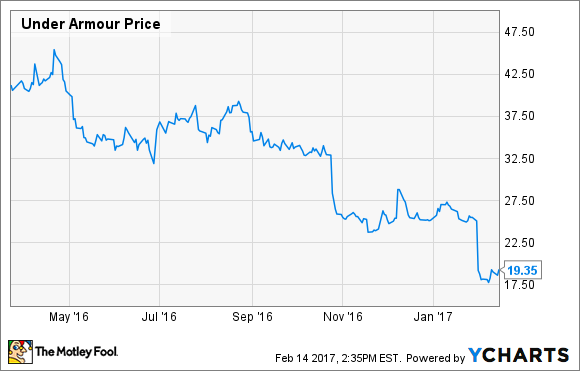Stocks can fall for a lot of reasons, but sometimes, the headwinds are only temporary, and in those cases, buying shares before share prices bounce back can be very profit-friendly. While no one knows for sure what's in store for these companies, I think that Illumina Inc. (ILMN 1.02%), Core Labs (CLB), and Under Armour (UA 1.08%) may head higher, rather than lower, in 2017. If so, then buying shares now when they're off their highs could pay off.
Getting in on game-changing medicine
You may have heard about personalized medicine, but if you haven't, you will soon. Increasingly, drugmakers are discovering that disease is caused by genetic mutations and that some patients respond better to specific treatments than they do to others. Such discoveries are revolutionizing how doctors treat patients, and Illumina's gene-sequencing machines are a big contributor to these advances.

IMAGE SOURCE: GETTY IMAGES.
Illumina's machines are the most commonly used to sequence genes by researchers, and with more than 7,500 sequencing systems installed, the company is perfectly positioned to benefit as governments and biopharma ramp up their spending on initiatives to map genomes.
Last year, Illumina's shares took a tumble following a slowdown in Europe early in 2016 and a slowdown in the U.S. at the end of the year. However, Europe has started to come back, and demand in America could begin to improve this year when Illumina launches its new NovaSeq 5000 and NovaSeq 6000.
These two new machines offer researchers unprecedented insight, at faster speeds, and for potentially a lower cost. As a result, management thinks that many of its existing clients will eventually upgrade from their legacy systems to these new systems. If so, then it could provide significant system sales growth that helps Illumina return to double-digit top-line growth.
The company's profit may also benefit from the launch of these new devices because management believes that these systems will allow researchers to conduct increasingly complex projects that otherwise would have been cost prohibitive. While sequencing a human genome cost more than $10,000 a decade ago, these machines could eventually bring the cost down to as low as $100. If so, then demand for high-margin consumables should climb.
An oil rally? Consider this stock
When energy companies want to determine where and how to drill for oil and gas, they turn to Core Labs, a global oil and gas services company. Core Labs is relied upon to evaluate a well's potential and to boost its production.
Although Core Labs' revenue has dropped alongside a global decline in oil and gas commodity prices, there are some signs that a rebound in commodity prices is coming, and if so, then sales and profit at the company should tick up.
According to Baker Hughes, there are 721 rigs active in the U.S. right now, up from 541 a year ago. The bounce-back in rig activity could accelerate from here, too, if Donald Trump's plans for energy independence provide access to federal lands and reduce imports.
In Q4, increasing exploration and production activity appears to already be supporting Core Labs' financials. The company's $150 million in fourth-quarter revenue was due in part to a 13% sequential increase in U.S. land revenue. Management also told investors in its fourth-quarter earnings release that it thinks that the deepwater oil and gas market could bottom in the first half of this year.
Assuming oil and gas activity continues to pick up steam, Core Labs should be able to leverage sales growth against fixed costs for significant margin expansion, and that could fuel a big rebound in this company's stock price.
Getting back in the race
Under Armour is about as down on its luck as any stock. While the market has rallied to all-time highs, this athletic apparel company's stock has dropped to multi-year lows.
One of the big reasons behind Under Armour's sliding share price has been the bankruptcy of The Sports Authority, one of the largest U.S. sporting goods chains. The unraveling of this retailer negatively impacted the company's inventory and premium pricing strategies, and those headwinds overshadowed what would otherwise have been considered impressive sales growth in its international and direct-to-consumer businesses.
Certainly, it may be a bit before all of Under Armour's troubles are behind it; however, investors don't seem to be giving this company enough credit for the growth it posted last year in spite of its challenges. In 2016, sales still grew 22%, and international and direct-to-consumer sales skyrocketed 63% and 27%, respectively, from 2015. Momentum abroad and in its direct-to-consumer channel could help management over-deliver on its guidance for 11% sales growth this year, especially since comparisons will get easier as the company moves past the anniversary of 2016's weak results.
If I'm right, then buying Under Armour shares now -- when they're beaten up -- and holding them for the long term could be very profit-friendly. After all, there's a lot of money in this industry that's still up for grabs. Under Armour's $4.8 billion in sales last year are still far below the sales of Nike and Adidas, which reported sales of $33.5 billion and $20.9 billion, respectively, in 2016.



